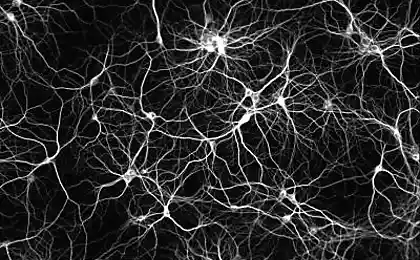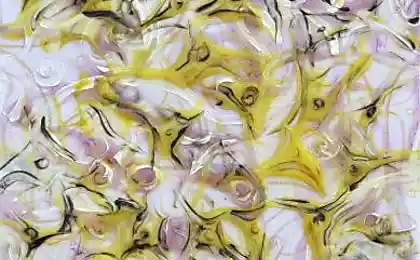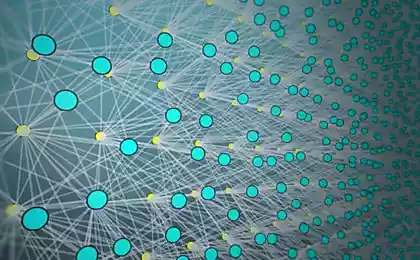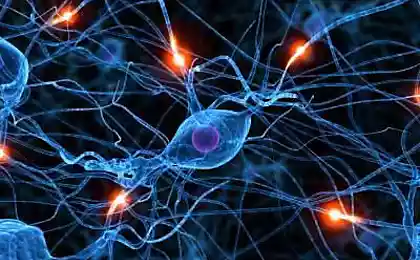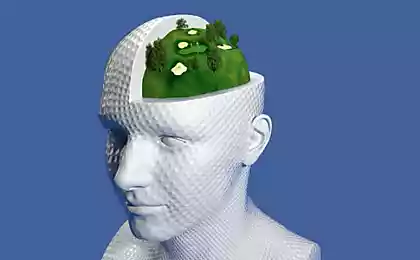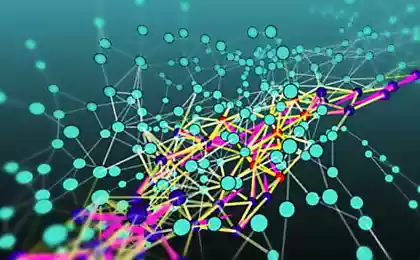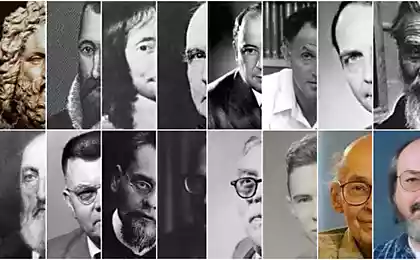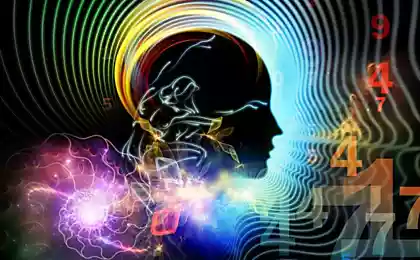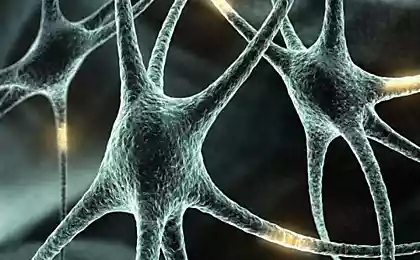558
Neuron. As the idea is born
Today let's talk today about the place where born and die thought. We will focus on the neuron.
Neuron is the structural and functional unit of the nervous system. So a neuron in Wikipedia name-calling. In General, all the elementary cells are similar in structure. Shell, cytoplasm, nucleus with nucleolus. Like an amoeba without some details.
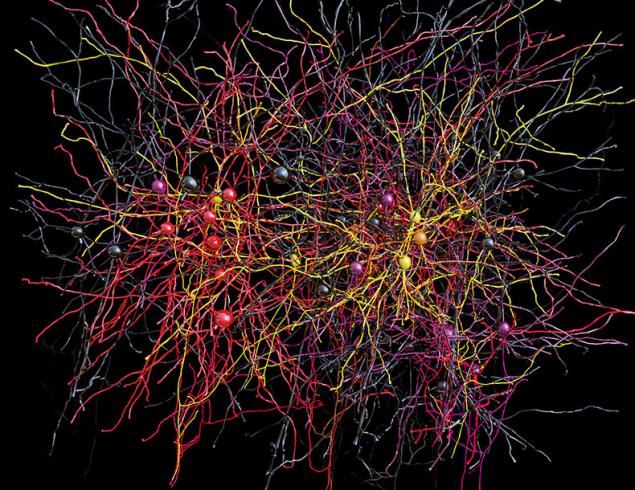
Speaking of which... Sheath of a neuron consists of lipids (in essence of fat). Through the shell of the neuron receiving power. It skips the fat-soluble substances such as oxygen and glucose. Natural sheath of a neuron is constantly updated, like everything else in the body. So think about it, fans of low-calorie diet the consumption of fat. You greatly run the risk that your emaciated brain will remain without sweet.
Neurons are different: bezzakonie, unipolar, pseudounipolar, bipolar, and multipolar neurons. Distinguish them in structure and functionality, in addition to betaxolola. He sits himself in the spinal cord, sad and not doing anything, and may do, but nobody cares. Maybe he still sad Us, he is also not interested, and we are interested in multipolar neuron. It is a structural unit of the cerebral cortex. Our neuron is different from the rest... of course a Lot different but what we need is its processes. And so, our neuron has one axon and multiple branching dendrites.
In our context, the dendrites is a ten on our target. It is them we need to build up and develop. It is the dendrites form our neural network, communicating with other neurons. With the growth of the dendrite (Yes, in General, like the axon) to the end there is a small thickening.
The so-called "cone of growth". It is not static and is in constant motion. It's as if the column erected many workers constantly lay new bricks, and fuss whatever. And building material to the growth cone, is transferred to membrane vesicles on the microtubule cytoskeleton of the neuron, which in turn consists of the protein "tubulin".
This growth is moving at a speed of about one millimeter per day. Sadly, it would be faster. But the way the world is, things take time. And by the way, one millimeter on the scale of the neuron is not so slow. What does the dendrite? Why is it needed?
The dendrite receives signals from the axon of the neighboring neuron across the synaptic cleft:) Okay... 'll get To that. And now let's talk about AXONE. Is another outgrowth of a neuron and the dendrite of the contrast he is one. In the same way as dendrite has a tubular structure. At its base, the body of the neuron has aksonnogo mound, which is the trigger zone of a neuron (area of greatest excitability).
The top is covered in a myelin sheath (at the dendrite it is not). To its end the axon branches into effector nerve endings (terminals). These terminalej the axon joins the dendrites of neighboring neurons. But it happens that it connects bodies of adjacent neurons and other nerve, forming akso-somatic and akso-axonal synapses.
Latest involved in the processes of inhibition. And so, the meaning of life is the axon transmits nerve impulses away from the body of the neuron to the dendrites of neighboring neurons. The axon transportorul neuromediatory (dopamine, adrenaline, serotonin, etc.) through which it acts on the dendrites of neighboring neurons. And a whole mountain of biomolecules, which to write this article does not make sense.
Next is the synapse. In fact, the neurons do not touch each other but are in contact at a synapse. The synapse or synaptic cleft is the junction of the dendrites and the axon. Among themselves they communicate by neurotransmitters (hormones) are secreted (released) into the synaptic cleft from the axon terminali.
Breaking the synapse, the neurotransmitters enter the receptor area of the dendrites of neighboring neurons. Receptor zone of dendrites election. I.e. for each neurotransmitter are receptor.

How is born the idea?
I hope we all remember from the school course "physics" that the electric current is directed movement of charged particles. So in the neuron including the charged particles are ions of potassium, sodium, chlorine, etc. Forgot to say that on top of the lipid envelope of the neuron is a layer of protein that forms potassium and sodium channels which leads to the interior of the neuron.
At rest, these channels are closed. Positively charged ions outside the neuron and negatively charged ions inside the neuron. Thus, the membrane of the neuron occurs the voltage difference. This state is called resting potential.
Further, the neurotransmitters are trapped in the neuron via the receptors of the dendrite, causing it and the chemical change inme, which in turn leads to opening of ion channels and the ingress of charged ions from the surface of the shell inside of the neuron. This process in a neuron is called a depolarization and is accompanied by a change in voltage and as a result => discharge.
9 shocking facts about personal hygiene of the Europeans in the eighteenth century
Find out what things have no place in your wardrobe!
This discharge is called the action potential or nerve impulse. This, is exactly the "piece of mind". Further, the potassium-sodium balance in the cell is restored using the potassium-sodium pumps (one of the specialized proteins of the neuron), and our nerve impulse flew further through the axon to other neurons changing and Megas. And so it goes. I hope it was interesting. Or at least understandable.
P. S. And remember, only by changing their consumption — together we change the world! ©
Source: s-mind.ru/nejron-ili-kak-rozhdaetsya-mysl/
Neuron is the structural and functional unit of the nervous system. So a neuron in Wikipedia name-calling. In General, all the elementary cells are similar in structure. Shell, cytoplasm, nucleus with nucleolus. Like an amoeba without some details.

Speaking of which... Sheath of a neuron consists of lipids (in essence of fat). Through the shell of the neuron receiving power. It skips the fat-soluble substances such as oxygen and glucose. Natural sheath of a neuron is constantly updated, like everything else in the body. So think about it, fans of low-calorie diet the consumption of fat. You greatly run the risk that your emaciated brain will remain without sweet.
Neurons are different: bezzakonie, unipolar, pseudounipolar, bipolar, and multipolar neurons. Distinguish them in structure and functionality, in addition to betaxolola. He sits himself in the spinal cord, sad and not doing anything, and may do, but nobody cares. Maybe he still sad Us, he is also not interested, and we are interested in multipolar neuron. It is a structural unit of the cerebral cortex. Our neuron is different from the rest... of course a Lot different but what we need is its processes. And so, our neuron has one axon and multiple branching dendrites.
In our context, the dendrites is a ten on our target. It is them we need to build up and develop. It is the dendrites form our neural network, communicating with other neurons. With the growth of the dendrite (Yes, in General, like the axon) to the end there is a small thickening.
The so-called "cone of growth". It is not static and is in constant motion. It's as if the column erected many workers constantly lay new bricks, and fuss whatever. And building material to the growth cone, is transferred to membrane vesicles on the microtubule cytoskeleton of the neuron, which in turn consists of the protein "tubulin".
This growth is moving at a speed of about one millimeter per day. Sadly, it would be faster. But the way the world is, things take time. And by the way, one millimeter on the scale of the neuron is not so slow. What does the dendrite? Why is it needed?
The dendrite receives signals from the axon of the neighboring neuron across the synaptic cleft:) Okay... 'll get To that. And now let's talk about AXONE. Is another outgrowth of a neuron and the dendrite of the contrast he is one. In the same way as dendrite has a tubular structure. At its base, the body of the neuron has aksonnogo mound, which is the trigger zone of a neuron (area of greatest excitability).
The top is covered in a myelin sheath (at the dendrite it is not). To its end the axon branches into effector nerve endings (terminals). These terminalej the axon joins the dendrites of neighboring neurons. But it happens that it connects bodies of adjacent neurons and other nerve, forming akso-somatic and akso-axonal synapses.
Latest involved in the processes of inhibition. And so, the meaning of life is the axon transmits nerve impulses away from the body of the neuron to the dendrites of neighboring neurons. The axon transportorul neuromediatory (dopamine, adrenaline, serotonin, etc.) through which it acts on the dendrites of neighboring neurons. And a whole mountain of biomolecules, which to write this article does not make sense.
Next is the synapse. In fact, the neurons do not touch each other but are in contact at a synapse. The synapse or synaptic cleft is the junction of the dendrites and the axon. Among themselves they communicate by neurotransmitters (hormones) are secreted (released) into the synaptic cleft from the axon terminali.
Breaking the synapse, the neurotransmitters enter the receptor area of the dendrites of neighboring neurons. Receptor zone of dendrites election. I.e. for each neurotransmitter are receptor.

How is born the idea?
I hope we all remember from the school course "physics" that the electric current is directed movement of charged particles. So in the neuron including the charged particles are ions of potassium, sodium, chlorine, etc. Forgot to say that on top of the lipid envelope of the neuron is a layer of protein that forms potassium and sodium channels which leads to the interior of the neuron.
At rest, these channels are closed. Positively charged ions outside the neuron and negatively charged ions inside the neuron. Thus, the membrane of the neuron occurs the voltage difference. This state is called resting potential.
Further, the neurotransmitters are trapped in the neuron via the receptors of the dendrite, causing it and the chemical change inme, which in turn leads to opening of ion channels and the ingress of charged ions from the surface of the shell inside of the neuron. This process in a neuron is called a depolarization and is accompanied by a change in voltage and as a result => discharge.
9 shocking facts about personal hygiene of the Europeans in the eighteenth century
Find out what things have no place in your wardrobe!
This discharge is called the action potential or nerve impulse. This, is exactly the "piece of mind". Further, the potassium-sodium balance in the cell is restored using the potassium-sodium pumps (one of the specialized proteins of the neuron), and our nerve impulse flew further through the axon to other neurons changing and Megas. And so it goes. I hope it was interesting. Or at least understandable.
P. S. And remember, only by changing their consumption — together we change the world! ©
Source: s-mind.ru/nejron-ili-kak-rozhdaetsya-mysl/


